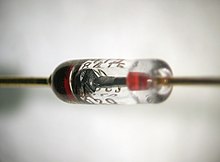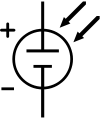Sunday, April 25, 2010
Dell To Launch Its Own Mobile Phone
The phone will be available with an extended 11 cm (4.1") OLED display, a 1GHz QSD8250 Snapdragon processor, and comes equipped with 1GB of flash with 512MB Ram, and a MicroSD card with additional 8GB of storage.

Friday, April 9, 2010
Diode
In electronics, a diode is a two- terminal electronic component that conducts electric current in only one direction. The term usually refers to a semiconductor diode, the most common type today, which is a crystal of semiconductor connected to two electrical terminals, a p.n junction. A vacuum tube diode, now little used, is a vaccume tube with two electrodes; a plate and a cathode
The most common function of a diode is to allow an electric current in one direction (called the diode's forward direction) while blocking current in the opposite direction (the reverse direction). Thus, the diode can be thought of as an electronic version of a check valve. This unidirectional behavior is called rectification , and is used to convert alternating to direct current, and extract modulation from radio signals in radio receivers.
However, diodes can have more complicated behavior than this simple on-off action, due to their complex non linear electrical characteristics, which can be tailored by varying the construction of their pn junction. These are exploited in special purpose diodes that perform many different functions. Diodes are used to regulate voltage zener diode, electronically tune radio and TV receivers (varactor diode), generate radio frequency diode tunnel diode, and produce light (light emitting diode)


Solar cell

Applications and implementations
Solar cells are often electrically connected and encapsulated as a module. Photovoltaic modules often have a sheet of glass on the front (sun up) side, allowing light to pass while protecting the semiconductor wafers from the elements . Solar cells are also usually connected in series in modules, creating an additive voltage.
above figure is systematic symbol of solar cell
onnecting cells in parallel will yield a higher current. Modules are then interconnected, in seri
es or parallel, or both, to create an array with the desired peak DC voltage and current.
The power output of a solar array is measu
red in watts or kilowatts. In order to calculate the typical energy needs of the application, a measurement in wattshours, kilowatt-hours or kilowatt-hours per day is often used. A common rule thumb is that average power is equal to 20% of peak power, so that each peak kilowatt of solar array output power corresponds to energy production of 4.8 kWh per day (24 hours x 1 kW x 20% = 4.8 kWh)
To make practical use of the solar-generated energy, the electricity is most often fed into the electricity grid using inverters (grid-connected photovoltaic systems); in stand-alone systems, batteries are used to store the energy that is not needed immediately.
Solar cells can also be applied to other electronics devices to make it self-power sustainable in the sun. There are solar cell phone chargers, solar bike light and solar camping lanterns that people can adopt for daily use.







